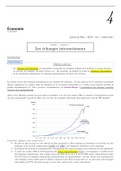Lecture notes
Coastal Landscapes and Change Enquiry Question 2 - A Level Geography
- Module
- Unit 1 - Dynamic Landscapes
- Institution
- PEARSON (PEARSON)
This document contains detailed notes on Enquiry Question 2 of the Coastal Landscapes and Change topic for the A Level Geography course. It includes all the information required to secure at top grade in this part of the course. These notes took me many hours to complete and are how I revised for m...
[Show more]




